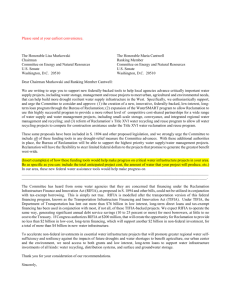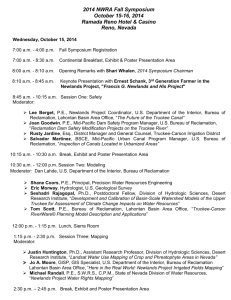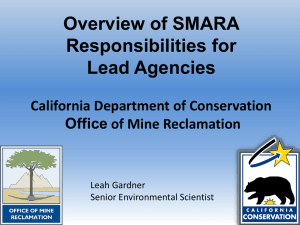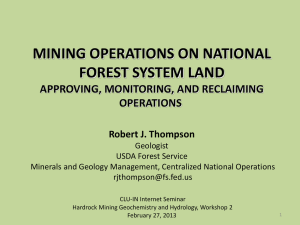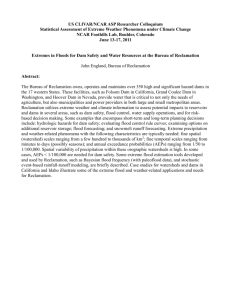Incentives and Disincentives for Managing Conflict
advertisement
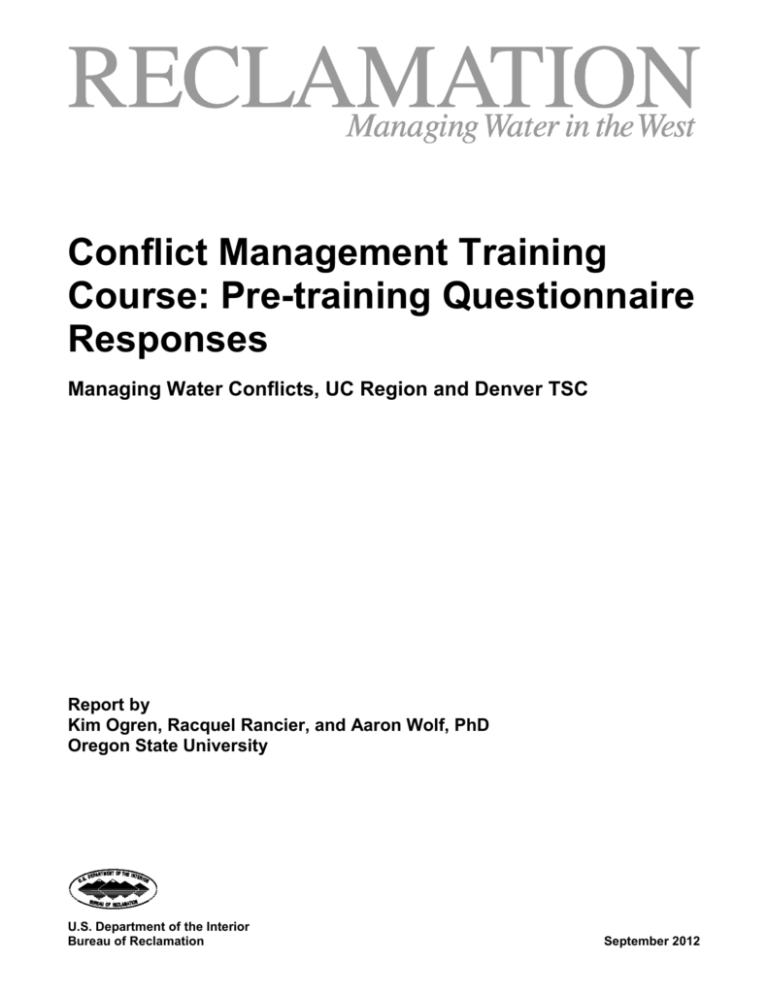
Conflict Management Training Course: Pre-training Questionnaire Responses Managing Water Conflicts, UC Region and Denver TSC Report by Kim Ogren, Racquel Rancier, and Aaron Wolf, PhD Oregon State University U.S. Department of the Interior Bureau of Reclamation September 2012 Disclaimer: The findings and conclusions in this report are those of the author(s) and do not necessarily represent the views of Reclamation. Contents Page Introduction ........................................................................................................... 1 Experience with Conflict ...................................................................................... 2 Percent of Time Spent Dealing with Conflict ................................................... 2 Types of Conflict .............................................................................................. 4 Examples of or Contributors to Conflict ........................................................... 6 Skills and Training Needed to Address Conflict ................................................ 7 Incentives and Disincentives for Managing Conflict ......................................... 8 Incentives for Managing Conflict ..................................................................... 9 Disincentives for Managing Conflict .............................................................. 10 Summary and Conclusion .................................................................................. 10 Introduction For the past five years (2008-2012), Dr. Aaron Wolf from Oregon State University (OSU) conducted five conflict management training workshops at Bureau of Reclamation (Reclamation) offices in Bismarck, North Dakota; Phoenix, Arizona; Billings, Montana; Albuquerque, New Mexico; Sacramento, California; Boise, Idaho; Salt Lake City, Utah; and Boulder City, Nevada. At the beginning of each session participants were asked to complete a questionnaire pertaining to conflict management and collaboration at Reclamation. The purpose of this questionnaire was two-fold. First the questionnaire answers provided the course instructor with guidance on how to tailor the course to the needs of the participants at the training. While a standard set of concepts and information is shared and the same skills were taught at each course, certain components of the course were emphasized or given more time based on the needs of the course participants at each location. The second purpose of the questionnaire was to assess how much and what type of conflict Reclamation employees experience at work and understand what skill development is desired from employees at Reclamation. This information can be used to better equip Reclamation employees for conflict management in the future through additional training. While the report offers a glimpse of Reclamation’s experience with conflict care should be taken in extrapolating this information to the whole office or Reclamation because this is not a representative sample of the office populations or Reclamation. This report presents the findings from the questionnaire from all five locations. The questionnaire posed the following four questions: 1. How much time of your time is spent managing conflict? 2. At what level is most of the conflict you deal with? (a-f & examples) 3. What skills do you feel would be most useful to enhance your capacity for effectively managing conflict? What skills do you feel your colleagues would best benefit from? Stakeholders you encounter? 4. What do you feel are the institutional incentives and or/disincentives for effectively managing conflict? For working proactively to prevent conflicts? The Albuquerque, New Mexico training included both Reclamation employees and Reclamation stakeholders. All other participants were Reclamation employees. The total numbers of questionnaires completed per location are included in Table 1 below. 1 Table 1. The number of responses per training location. LOCATION FREQUENCY Phoenix 9 Bismarck 16 Albuquerque 25 Billings 17 Sacramento 13 Boise 10 Salt Lake City 9 Boulder City 31 Total 130 Experience with Conflict To gain a better understanding of what type of conflict is experienced by Reclamation employees and how much of their time it consumes a series of questions were asked. Respondents were also asked to provide examples of conflicts they had experienced. Percent of Time Spent Dealing with Conflict Respondents were asked, “How much time of your time is spent managing conflict?” Most responded with a percentage of their time spent managing conflict, and those that did not include a percent were labeled as “other.” The amount of time spent managing conflict varies between and within offices (Figure 1). The amount of time spent managing conflict in each of the offices varies. The Billings office reported spending the least amount of time managing conflict while the course participants in Salt Lake City reported spending the most time. While a plurality of the total number of participants surveyed indicated they 0-24% of time spent managing conflict as what the most individuals reported, 40% of all respondents reported spending over half their time at work (50-100%) managing conflict (Figure 2). Sixty percent of course participants indicated that they spent at least a quarter of their time managing conflict (31.5% spent less than a quarter of their time and 8.5% indicated some other amount, e.g., “a lot”). 2 Time Spent Managing Conflict 100% 4.0% 3.2% 5.9% 20.0% 25.0% 17.6% Number of Respondents 11.1% 30.0% 30.8% 12.9% 80% 5.9% 70% 60% 11.1% 9.7% 90% 33.3% 12.5% 28.0% 11.8% 22.6% 55.6% 30.0% 50% 30.8% 25.0% 22.2% 40% 10.0% 28.0% 30% 58.8% 11.1% 51.6% 25.0% 11.1% 30.8% 20% 30.0% 10% 22.2% 20.0% 22.2% 12.5% 7.7% 0% Albuquerque (2009) Billings (2009) Bismarck (2008) 0-24% Boise Boulder City (2011) (2012) Reclamation Survey Location 25-49% 50-74% Phoenix (2008) 75-100% Sacramento Salt Lake City (2011) (2012) Other Figure 1. Time spent managing conflict – individual workshop breakdown 3 Time Spent Managing Conflict (all locations) 8.5% 31.5% 18.5% 21.5% 0-24% 25-49% 20.0% 50-74% 75-100% Other Figure 2. Time spent managing conflict – all responses Types of Conflict Participants were asked “At what level is most of the conflict you deal with?” and were presented with six choices and asked to provide an example. Some respondents only selected one type of conflict choice, presumably the one they deal with the most. Other respondents circled multiple types of conflict they have experienced. Overall, in each office and across all five offices, the conflict most reported is “intersectoral/interstakeholder” conflict and next is interpersonal (Figure 3). The responses follow this same overall trend at some locations (e.g., Albuquerque, Bismarck, and Sacramento) while in other locations interoffice/ interagency conflict was one of the top types of conflict reported (Figure 4). Types of Conflict Encountered Number of Times mentioned 90 83 80 69 70 62 60 50 40 33 27 30 20 14 10 0 Type of Conflict Intrapersonal Interagency/ Interoffice Interpersonal Intersectoral/ Interstakeholder Figure 4. Types of conflict encountered for all training locations 4 Type of Conflict Encountered 29 30 26 Number of Times mentioned 25 21 20 16 15 15 13 9 10 9 5 5 5 3 10 10 1 2 2 3 2 2 7 6 5 4 2 9 8 2 3 1 7 6 6 4 1 9 7 5 6 4 2 1 0 Albuquerque (2009) Billings (2009) Bismarck (2008) Boise (2011) Boulder City (2012) Phoenix (2008) Sacramento (2011) Salt Lake City (2012) Reclamation Office Intrapersonal Interpersonal Interagency/ Interoffice Intersectoral/ Interstakeholder Interstate International Figure 4. Types of conflict encountered at different training locations 5 Examples of or Contributors to Conflict Respondents were asked to provide examples of the types of conflict experienced. A variety of responses were obtained some of which specifically referenced a conflict, e.g., the Middle Rio Grande Collaborative Program, while others were more generalized, e.g., working with stakeholders (Table 2). The most commonly referenced conflict was competing water interests, rights, and uses. Respondents also listed conflict with other government agencies, stakeholders and within the Bureau or their office. Other examples listed included conflict centered around issues of funding, differences in priorities, expectations, and outcomes, and issues implementing the Endangered Species Act. Table 2. Examples of conflict Example of Conflict Code Competing water interests, rights, and uses Internal politics (such as employees vs. managers, tension in work groups, and lack of direction on program guidelines) Coordinating and communication within Reclamation Working with other government agencies Working with stakeholders Roles and responsibilities (e.g., who is in charge and has authority) Working with tribes Funding/fiscal issues Mexico - quantity and quality disagreements Difference in product/outcome expectations Endangered Species Act (ESA) requirements and implementation Differences in opinion on technical matters Middle Rio Grande Collaborative Program Project priorities Finances/budget Interpretation of policies and regulations Lack of understanding of project costs, time requirements or federal regulations and policies Glen Canyon Dam Lower Basin States Personality clashes Contractor State historic preservation Implementation of NEPA Noncompliance Upper vs. Lower Basin States Scope of work Planning studies Basin studies Upper Colorado River Recreation Program Count 28 19 11 10 9 9 8 7 7 6 6 5 5 5 4 4 3 3 3 2 2 2 1 1 1 1 1 1 1 6 In the examples of competing interests and uses, respondents listed competing groups and groups as well as programs/locations with conflict. Specific competing interests listed included conservation/environmental protection vs. water use, irrigation vs. power interests, state vs. tribes, Mexico, Canada, and each other, recreation vs. other interests, and water leases. Locations with conflict listed included, Lower Colorado River, Glenn Canyon, Edward Aquifer, Rio Grande River, and Pecos River. Some of the examples cited for inter-government conflict listed were conflicts with the Department of Agriculture, Army Corps of Engineers, Bureau of Indian Affairs, and state governments. Skills and Training Needed to Address Conflict To get an understanding of what participants wanted to get out of the workshop and what skills they thought other could improve, participants were asked “What skills do you feel would be most useful to enhance your capacity for effectively managing conflict? What skills do you feel your colleagues would best benefit from? Stakeholders you encounter?” Few respondents answered each question individually; therefore, the responses are pooled together as universal skills for all parties (Table 3). The top skills listed as most useful included communication, listening, and understanding other positions and perspectives. Other themes from the responses include the need for training in conflict management, negotiation, working towards a compromise, and remaining calm during tense meetings or projects with high amounts of conflict. Reclamation employees also expressed particular interest in interest based bargaining (versus position based bargaining). 7 Table 3. Skills respondents found most useful to help them manage conflict Skill Frequency Communication 40 Understand other positions and perspectives 35 Listening 30 Conflict management/resolution techniques 16 Negotiation 10 How to work towards compromise 9 Keep calm and remaining level-headed 9 Patience 6 How to be direct/assertive 6 Collaboration 5 Preparing for, anticipating, and recognizing problems 5 Open mindedness 5 Facilitation 4 Not taking things personally 4 Moving past entrenched thinking/positions 4 Teamwork/teambuilding 4 Interest based bargaining vs. position based bargaining 4 Building trust and relationships 3 Coming up with creative solutions 3 Decision making 3 Empathy 2 Adaptive management 1 Better understanding of federal and state laws 1 Learning from past experiences 1 Identify needs vs. wants 1 Managing expectations 1 Avoiding triangulation 1 Showing no emotion 1 Following through 1 Preparing for meetings 1 Taking long term view 1 Anger management 1 Incentives and Disincentives for Managing Conflict In this final question, respondents were asked “What do you feel are the institutional incentives and or/disincentives for effectively managing conflict? For working proactively to prevent conflicts?” The responses to these questions are provided below. It should be noted that some failed to specify “incentive” or “disincentive” which left some answers up to interpretation as to which group the response was meant to include. Another study under this program/initiative is currently conducting a more detailed analysis of incentives and disincentives for 8 conflict prevention and management in the Bureau of Reclamation. Results will be available in the fall of 2012 in the report entitled, “An Investigation of Incentives and Disincentives for Conflict Prevention and Mitigation in the Bureau of Reclamation’s Water Management.” Incentives for Managing Conflict The most common incentive reported for managing or preventing conflict was higher productivity and efficiency (Table 4). The second most common incentive mentioned was the fact that preventing or managing conflict produced a better end result or solution to the problem at hand. These two themes tie in with another incentive mentioned--the fact that such efforts allow the agency to fulfill its mission or meet project goals. Another set of themes was that such efforts save money, improve or develop strong relationships, as well as foster cooperation and teamwork within the Bureau and with partner agencies and stakeholders. Other commonly reported incentives were the fact that conflict prevention would reduce stress experienced by Reclamation employees, create a better work environment, avoid litigation, and improve Reclamation’s ability to solve problems. Notably, receiving an award for conflict prevention was only listed twice and meeting the “collaborative competency” performance requirement was only mentioned twice. Table 4. Incentives reported for conflict prevention Incentives Count Higher productivity and efficiency 29 Improved problem solving or better end result 18 16 Cooperation and teamwork fostered Higher cost savings Improved relationships 14 12 Better work environment 12 Agency mission better fulfilled 9 Reduced job stress and turmoil 7 Litigation avoided 6 Improved communication Personally enjoy being part of the solution, cooperating, & collaborating 5 4 Intervention by Regional Office, Washington, and Congress avoided 3 Bad public relations attention avoided 2 Performance evaluation requirement met 2 2 Pressure from higher management Resources available Awards received 2 1 Ability to foresee conflict before it arises 1 Training available 1 9 Disincentives for Managing Conflict The most noted disincentive for managing and preventing conflict is the lack of resources (Table 5). Specifically, time and funding were two resources that course participants identified as disincentives for managing and preventing conflict. With the resources available to do the work, Bureau employees do not have an incentive to pursue that course of action. Another commonly mentioned disincentive was the and how challenging pursuing conflict prevention can be. The rigid process and regulations Reclamation must follow to do its work is seen as preventing employees from pursuing conflict management and prevention. Management, politics and institutional inertia are also noted as impediments. Table 5. Disincentives reported for conflict prevention Disincentive Count Lack of resources - all 20 Lack of resources - time 9 Lack of resources - funding 7 Lack of resources - general 4 Hard to do/discomfort 14 Rigid process and regulations limit options 11 Management Politics 11 7 Institutional inertia 4 Threatens job security 4 Lack of training/skills 3 Could offend 3 Lack of recognition 2 Cooperation/collaboration viewed waste of resources 2 Risk aversion 2 Resource intensive 2 May have to give in or compromise 2 Internal team conflict Lack of agency support 2 1 Litigation 1 Hidden agendas of those involved 1 Summary and Conclusion The questionnaire completed at five conflict management training “miniworkshops” at Bureau of Reclamation (Reclamation) offices in Bismarck, North Dakota; Phoenix, Arizona; Billings, Montana; Albuquerque, New Mexico; Sacramento, California; Boise, Idaho; Salt Lake City, Utah; and Boulder City, 10 Nevada set out to 1) aid the course instructor in determining how to tailor the course to best fit the participants at that course location and 2) assess how much and what type of conflict Reclamation employees experience and understand what skill development is desired from employees at Reclamation. The salient findings from the questionnaire include the: Forty percent of individuals indicated spent over half their time of their time managing conflict, while 31.5% spent about a quarter of their time and 20% spent a quarter to half their time managing conflict Type of conflict most reported across all responses is “intersectoral/interstakeholder” conflict followed by “interpersonal” Most frequently cited examples of conflict were conflicts over competing water uses Skills most frequently listed as desired were communication, listening, and understanding other positions and perspectives Primary incentives for managing and preventing conflict were the fact that it results in higher productivity and efficiency as well as leads to better solutions, allows for more cooperation and teamwork, saves money, and improves relationships Primary disincentives for managing and preventing conflict were a lack of resources (e.g., time and funding), the fact that conflict management is hard to do, and limited options due to regulations and rigid Reclamation processes From these responses it is apparent that Reclamation employees face a number of challenges regarding cooperation and conflict management. Conflict is experienced to some degree at all levels and can consume a large amount of time. A number of factors serve to Reclamation employees have identified a number of skills they feel that they could benefit from through further development in training. These skills would help both reduce and address conflict encountered by Reclamation employees. From the incentives and disincentives reported, it appears that Reclamation employees are away of the benefits of cooperation, collaboration, and conflict management/prevention. Those benefits motivate employees to pursue conflict prevention and management. However, at the same time several disincentives serve as barriers to pursuing that course of action. A more comprehensive evaluation of incentives and disincentives for conflict management and prevention is available in the forthcoming Reclamation report entitled, “An Investigation of Incentives and Disincentives for Conflict Prevention and Mitigation in the Bureau of Reclamation’s Water Management.” 11

